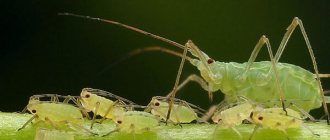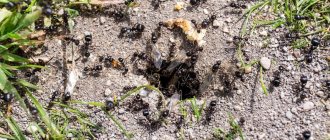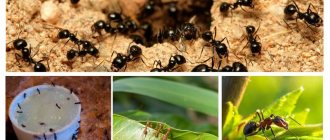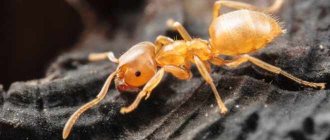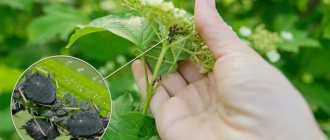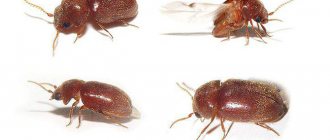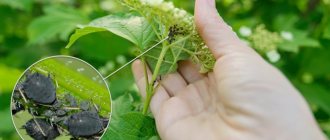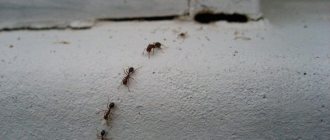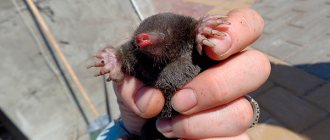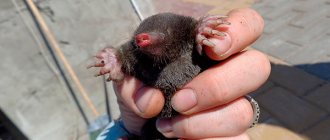We always cite ants as an example of organization and hard work. But, unfortunately, when these qualities are used against us, we understand that we cannot do without help! So let's figure out whether we need to kick them out of our gardens? If necessary, what is the best way to do this? When and what radical methods should we use in the fight against those who manage our garden beds?
But why start desperate battles with ants? These small insects live so unnoticed that it seems that you can easily get along with them. But in reality, everything is far from so simple. They bring with them huge problems for gardeners, flower growers and horticulturists. But are they any use? Is it possible to “tame” insects and benefit from such a symbiosis?
How to get rid of ants on your property using folk remedies
Agree, even if you really need to exterminate or drive away insects from the site, you don’t want to sacrifice your garden by poisoning the soil, and the loss of the harvest didn’t suit anyone. That is why there are both aggressive means of control and more gentle, but no less effective means, which were found not in laboratories, but experimentally by gardeners themselves.
Boric acid. We'll talk about it in more detail a little later.
Baking soda. It is more suitable for exterminating colonies or small anthills.
There are several options for using this tool:
- A mixture of water (2 l) and soda (2 tbsp) is shaken well until the soda grains are completely dissolved. You need to water the anthill with this water. Cover it with soil and cover it with dark film, roofing felt or linoleum.
- You can add sugar (2 tbsp) to the mixture to attract insects.
- A more harsh method - baking soda mixed with vinegar will give a strong corrosive reaction. Within 5-10 minutes the pests die.
- Using undiluted soda is also effective. Anthills are covered with it.
One moment! In large quantities, baking soda can damage the soil.
Ammonia. Another tool that no gardener can do without. Ammonia is used in different ways:
- Water the anthills (solution: water - 5 l, alcohol - 2 tbsp).
- Leave the cloth soaked in the solution on the ant nest and cover it with film on top.
- Spray the plants with a solution of water (10 l) and ammonia (10 ml). By the way, if you mix 10 liters of water, 50 ml of ammonia and 10-15 ml of shampoo, this product can destroy aphids.
- Pour an alcohol solution under the root of the plant.
The latter method of use also additionally fertilizes the soil, like nitrogenous bait.
Sugar and yeast. This means destroys the entire settlement. And the insects die of hunger, as the yeast triggers the fermentation effect and spoils all the previously collected food of the ants. How to use the product:
- Yeast (live) crumbles.
- Mix yeast and sugar in equal proportions. Just a little warm water is added (to start the yeast).
- Small balls are rolled out of the resulting mass.
- The balls are laid out near the anthill or where insects accumulate.
You can make the mass thinner and pour it into plates.
All these methods actually work. But it is also possible that one of the options does not suit you, then try another, look for a method that works in your case.
How to remove from the greenhouse
The use of chemicals against ants will not always be a convenient option for eliminating pests, especially if a greenhouse where cultivated plants grow is being treated. They will absorb poisons, so it is better to give preference to folk remedies.
There are three types of ants most often found in the garden: red, black and brown. If the beds are located near the forest, then more often the first type appears on the site. Greenhouses are inhabited by black garden insects that consume young shoots of seedlings and seeds. They make nests directly in the beds, and while laying paths, the root system is damaged. Without timely measures, the greenhouse will have loose soil and a large number of holes in the ground.
12 best ways to get rid of ants in a greenhouse
For work in a greenhouse, it is recommended to use valerian. The whole bottle is diluted in ten liters of water, after which the plants, soil and the anthill itself are sprayed. In addition, the mixture helps kill whiteflies and other pests.
Ammonia
Ammonia is often used at home to repel ants. To do this, make a solution based on ten liters of water and 1 tbsp. alcohol Also add up to 4 tbsp. Sahara. All anthills in the greenhouse need to be filled.
Read this article on how to get rid of ants using ammonia.
Before pouring the product, you need to let it sit for 30 minutes. When the mixture is homogeneous, you can fill the nests and spray the plants. Crops do not suffer any harm from this method, because the concentration is minimal, but sufficient to kill ants.
Millet and semolina
Anthills in greenhouses can not only be filled, but also dusted. For this, ash, slaked lime, chili pepper, and mustard powder are used. At home, it is recommended to use millet as an independent remedy or in combination with semolina. You need to pour grain into the anthill, which the insects mistake for eggs and carry it into the house. After this, pour water over everything to swell and block the paths. After some time, it begins to emit a smell that repels ants. A similar action can be carried out using semolina with sugar, which destroys the stomach.
Ammonium nitrate against ants will help for dusting. To do this, it is simply poured dry or diluted in a small amount of water and poured into the nest. A couple of days are enough to eliminate the ants. It is best to perform the operation in the morning or evening. An equally effective option would be to loosen the anthill and sprinkle it with tobacco.
Vinegar
To prepare the product, you need to pour 500 ml of sunflower oil into a bucket of water; if you don’t have it, then corn, flaxseed or hemp oil will do. Add any shampoo or soap and a liter of vinegar. Mix everything thoroughly and in places where ants are most concentrated, you need to make holes in the soil and pour the mixture. It is best to use a spray bottle for these purposes. After the procedure, cover the area with film for three days.
The vinegar solution can be made with diesel fuel, kerosene or gasoline. The method will be effective if the ants are in the foundation, under the blind area. The mixture is poured into the holes through a syringe.
Soda
Before planting crops in a greenhouse, it is recommended to prevent the spread of ants, even if there are no nests. To do this, use a soda solution with the addition of linseed oil. The recipe is simple: add 1 tbsp to a liter of liquid. soda and 30 ml of oil. Complete destruction of the colony can be done by digging up the soil in the greenhouse and filling the tunnels with ash, soda or quicklime. This powder not only repels, but also kills ants.
A good effect is obtained if you use repellers. Essential oils and herbs can be used for this. The main effect is the pungent aroma. It is recommended to use cinnamon or lavender on trails and under plants. Among the essential oils, fir, spruce, lavender or tea tree are best.
When eliminating ants from a greenhouse, you need to know when to stop. There is no need to try to remove all the ants, it is important to monitor the population. After all, complete elimination disrupts the soil ecosystem in the greenhouse, which can cause an attack by other parasites. After settling, they completely destroy competitors, including spider mites, whiteflies and others.
What to do if you are tormented by ants in the garden
In search of food and comfortable living conditions, ants have reached your site. How to evict uninvited “guests” now? There is a very important condition - you need to find where the colony is being built. It is there that the nest where the queen lives is located. Only she decides where her subjects will live.
Believe me, you won't be able to persuade the queen. But you can solve this problem in several ways:
- Move the nest, choosing more favorable living conditions for the colony.
- By killing the ants.
- Destroying the nest along with the queen.
To move you will need:
- Find the nest. To do this, it is worth following some insect: sooner or later, it will lead us “home”.
- Pick it up somewhere in the forest, on the bank of a river, etc. quiet bright place.
- Dig up the nest and move it, being careful not to damage anything.
- Leave sugar and sweets at the new settlement site.
It was a peaceful way.
As I already said, ants live in a warm place where we very rarely look. So let's change the living conditions for the “tenants”:
- We will continuously dig next to the anthill and excavate the nest itself.
- Let's shade the place as much as possible.
- Every day (or every other day) we will flood the area of land occupied by insects with water.
And if they don’t like something, let them leave! And away!
The nest can also be destroyed. For example:
- Dig deep to find and destroy the queen;
- Pour in lime;
- Set fire;
- Cover with ash and ashes.
There are also ways to use chemicals, but we’ll talk about them separately.
Safety precautions
When using all types of drugs or folk remedies, be sure to remember the safety rules:
- When carrying out processing, it is necessary to use protective gloves and, if necessary, a respirator.
- During work, you must not consume food or drinks.
- Baits should be placed in places protected from children and pets.
- When preparing solutions, do not use containers used for food purposes.
- All spraying and treatments are carried out only in dry, calm weather.
- Upon completion of work, hands must be thoroughly washed, clothes and shoes washed.
- You should always carefully read the labels and manufacturer's recommendations, observe the specified waiting period, during which you should refrain from contact with the treated surface. After using insecticides, it is necessary to strictly observe the deadlines for manual work.
Compliance with the rules listed above will avoid poisoning and other unwanted side effects.
Any chemicals used in the garden can affect our immediate environment. Their use must be taken into account, especially when children and animals (dogs, cats) live in the house. Chemicals also affect crops (vegetables, fruits) and other insects (for example, beneficial pollinators - bees).
Ants are one of the most common garden pests. Without timely treatment, their colonies quickly spread throughout the area, causing serious damage to various crops.
Removing ants from the garden with boric acid
The promised remedy is boric acid (boron). With its help, you can successfully fight ants. And boron works in 3 directions:
- Like bait. How to make the “poison” attractive to these insects? You need to mix borax (1/3 tsp) with sugar (1 tbsp), water (3 tbsp). The mixture is heated, after which it needs to be cooled and mixed with 1 tsp. honey The “bait” is ready!
- Bait. Boric acid powder is mixed with egg yolk, dough and bread crumb. Balls are rolled up and laid out throughout the site.
- The anthill is filled with acid. A solution of boric acid (1 tbsp) is mixed with sugar (4 tbsp). Their home is thoroughly irrigated with this mixture. After which the nest is covered with material through which air does not penetrate.
I remember very well how my grandfather and I placed balls of yolk and boron around our summer cottage. Then I ran around looking at the places where these “explosive mines” were “placed”. But soon many of them disappeared, just as the ants disappeared. By the way, since then goosebumps have been on our way around our dacha!
Black garden ant: lifestyle, description of the species
The black garden ant or black lasius is a species of ant of the genus Lasius found in many countries and territories. It is black lasius that is most often found in central Russia, even in cities and houses.
The black garden ant is typically colored black or dark brown. The body is covered with a large number of microscopic hairs. Body length from 3 to 11 mm depending on gender and class. The largest in anthills are the queens; they reach sizes from 7 to 11 mm; they are called large black ants and are especially feared. Queens can live a very long time (up to 28 years), regularly bearing offspring, while males live less than a year. There is usually one queen per anthill.
Black ants most often settle in loose soil, in rotten or weakened trees and under stones. Therefore, the dacha plot is ideal for living and breeding of black ants.
Ants feed on honeydew secreted by aphids and small invertebrates.
Fighting garden ants in the garden and vegetable garden without chemicals
I want to remove the ants very carefully. To do this, we will try to choose suitable means. It’s interesting how experienced gardeners and gardeners solve problems with them:
- Cover tree trunks with sticky tape to prevent insects from moving freely along the tree. Belts are: funnel-shaped; with adhesive, sticky tape; with a trap. An adhesive belt can be found in a specialty store, or you can make it yourself.
- Place pieces of cloth soaked in kerosene around the trunks of affected trees and bushes.
- Colonies of anthills with all their entrances and exits are filled with sunflower oil diluted in boiling water. You can and should add aromas that are unpleasant for murah: fennel, black pepper, bay leaf, camphor.
- Let's “feed” grains! We place semolina and millet near the anthills. The hope is that greedy insects will drag the prey home and eat it there. But the murakh’s stomach is not capable of digesting grains!
- We frighten with pungent odors. What ants really can’t stand is the pungent “aromas” of crushed garlic, onions, cinnamon, tomato sprigs, parsley, and herring (it’s better to take smoked herring).
- We treat tree trunks with lime in the spring.
- Sprinkle the ant paths with ash, salt, dry mustard, and soda.
- They are afraid of water and cannot overcome even streams 2 cm wide. You can make a clay moat with water around the tree.
For the garden and vegetable garden, you can use your own methods of exterminating insects.
Protection of trees and shrubs
- Experienced gardeners have devices in their arsenal that allow them to protect trees from ants. To do this, a cut car tire is placed around the trunk. The cut is located on top, which creates a groove that, after filling with water, insects will not be able to overcome. Strips of foil are attached to the trunks in several tiers, which are twisted into a cone and the top edge is folded back.
- It is recommended to whitewash trees in spring and autumn. It will protect against insects with tar, which is applied to the trunk with a strip made in the form of a ring. Ants will not be able to overcome the viscous mass. A strip of roofing material plays a similar role. The barrel is wrapped with it, and a long-drying adhesive substance is smeared on top. You can wrap it with double-sided tape, removing the top protective layer.
- They are tied to the stems and laid out on the surface of the soil: bunches of garlic, wormwood, tansy. The shoots of raspberries, blackberries, and currants are tied, retreating 15 cm from the ground, with narrow strips of sheepskin soaked in carbolic acid, with the wool facing out.
- To destroy already settled goosebumps, combine kerosene - 120 ml, tar soap ground into powder - 400 g, formic acid - 20 g. Pour the mixture with 10 liters of water while vigorously stirring. Shrubs and trees are irrigated every three days. A total of five treatments will be needed.
Measures to protect tree trunks and branches from ants
The appearance of ants in your summer cottage will not cause significant damage if you promptly begin using proven methods to repel and destroy them. It is important to prevent strong reproduction of aphids, remove plant debris, dig up the soil after harvesting, and protect the area with plants that repel insects.
Author of the article: Kamenkov Igor Dmitrievich
- Related Posts
- How to treat cabbage against pests - folk remedies, effective methods of insect control
- Honeysuckle: propagation, planting and care, features of growing in the country
- Effective methods of controlling mice in a private home using traditional methods
« Previous entry
The benefits and harms of ants in a summer cottage
Surprisingly, ants can be beneficial to your garden beds and plants! But, before I name the benefits for gardeners because these insects have settled on his plot, I will announce the significant disadvantages of this phenomenon:
- They build branched labyrinths and multiply quickly. As a result, an entire colony is created. Such underground colonies “sweep away” everything in their path. And then they definitely will not leave “their” territory.
- For their food, ants breed aphids, which destroy young seedlings and plant shoots.
- Insects feed on root crops, berries, and vegetables, which have a high sugar content.
A neighborhood under such conditions cannot be called friendly!
Now let's soften the bitter pill:
- Ants mercilessly deal with caterpillars and other pests: all this is food for ants!
- The soil also benefits; it is enriched with potassium and phosphorus. These fertilizers are applied to the ground in diluted form (this is how plants absorb them best).
Of course, one has only to remember aphids, and all the advantages do not seem so significant. And yet, in fairness, I tried to rehabilitate the ants. How successful is up to you!
Attracting Natural Enemies
To get rid of the unpleasant proximity to ants, you can add natural enemies to them. These include hedgehogs. These prickly creatures eat more than just apples and mushrooms. They are not averse to eating garden pests. Hedgehogs are omnivores and differ in the habits of predators. If you come across an anthill on the way, this creature will most likely destroy it and eat some of the inhabitants.
Settling several hedgehogs in a cultivated area will allow insects to quickly survive. Frogs are also not averse to eating ants. Their diet mainly consists of flies and mosquitoes. But for variety, they also eat ants. Garden pests will not like such a neighborhood. Moles, some breeds of birds, and lizards feed on ants.
What plants do garden ants not like?
This is probably the simplest and most ingenuous way to forget about ants: plant plants whose smell they cannot stand:
- Parsley;
- Tomatoes;
- Mustard;
- Mint;
- Onion;
- Marigold;
- Garlic;
- Carnation.
Some plants can be grown for harvest, and at the same time make an excellent ant repeller. Others - we grow them as garden decorations
Why do large black ants need wings?
As already mentioned, both male and female black garden ants have wings, but only large ones. They need them to create new colonies and allow them to move long distances. Worker ants (small ones) do not have wings, so they are not able to fly or move such long distances.
After fertilization, female black ants shed or chew off their wings.
How many legs does a black ant have?
The black garden ant has 6 legs and a pair of long antennae, which are sometimes confused with legs.
How to destroy red forest ants in the country
You have uninvited guests at your dacha who are trying to settle in. But the most unpleasant thing is that this type of ant is very aggressive. What to do:
- Keep your garden and home in order. No open garbage dumps.
- You need to get rid of the entire colony, consisting of several anthills!
- Boric acid is effective in the fight against red individuals. Use “feeding” with millet.
- We use repellent odors of herbs (we already talked about this a little higher). Herbs and plants can be grown, or freshly cut herbs can be placed near the “settlements”. I will supplement the list with plants and other products that have the properties we need: - lavender, - elderberry, - wormwood, - herbs and spices, - vegetable oil, - citrus fruits, - onion peels...
- One of the relatively “humane” methods is the forced eviction of pests . At dusk, when all the insects have returned “home,” take a shovel and dig out the entire anthill in two or three times. Quickly transfer it, along with its inhabitants, into a bucket and take it outside the site, preferably into the forest. Pour boiling water over the hole.
You can check how the other methods described above will work in the fight against red pests.
Use of traps and baits
Repelling ants is not always effective, because they can return, so it is better to use baits. Their popularity is due to their effectiveness, because they easily eliminate ants on the street, but are not suitable for houses or apartments.
It should be noted right away that there is no universal bait, so any means presented may work in one case, but in the second they will be ineffective. If you need to eliminate an entire anthill, then baits with fast poisons turn out to be weak. Same for traps.
Sweet
To prepare, you need to use minced meat or yolk and any sweetness, such as sugar, honey or jam. Mix the ingredients thoroughly, add about 20 grams of boric acid and make peas, placing them near the anthill. Similarly, you can mix sweets with coffee grounds to repel colonies.
Millet and semolina
With this method, grain is poured into or near the nest. The ants will carry it inside, closing the passages and disrupting the feeding process. The cereal must be covered to prevent it from being eaten by birds. In addition, everything is dusted with semolina and sugar, which helps destroy the gastrointestinal tract.
Sticky traps
Such methods are excellent for plant protection. You need to lay out traps near the trees that will distract insects and collect them in one place. They are sold in stores. For example, “Absolute” and “Clean House” gels are effective. They have a sweet smell and taste that attracts ants. It must be applied in dotted lines on the trails. It contains substances that are harmful only to ants.
Chemical repellents for ants in the garden
If you decide to act decisively, or there are no safe means, then let's see what chemicals are available:
- Diazion. These drugs are sprayed on low-growing berry and vegetable crops. Diazinon literally “hits the heart” of insects. It blocks the production of an enzyme responsible for the functioning of the nervous system of ants. They begin to have convulsions, leading to paralysis and death. In addition, it is actively absorbed by the root system of plants and protects them from pests for 2-3 weeks.
- Chlorpyrifos enters the body of insects through the respiratory system and paralyzes the nervous system. The chemical is retained in the soil for 110-120 days, and it remains effective against pests for about 1-2 months.
- "Thunder". The main active ingredient is diazinon. These are granules that are buried directly next to the anthill.
- Trilon B. effectively disinfects the area, poisoning insects.
- Globol. The drop kills up to 600 individuals!
- Raptor gel. A powerful means of destroying both red and garden ones.
- “Storm” pasta. Intexicide.
- FAS gel. It acts like Raptor, destroying worker ants, both black and red. Then everyone else is destroyed.
There are special tools, such as those named in this list. Perhaps the store will recommend other drugs to you. Be sure to share which ones suited you best.
If you liked the article, which contains everything about ants and ways to control garden pests, tell your friends about it, or better yet, just leave a link to this article on your social networks! Subscribe and you will receive useful and informative articles like this regularly!
As recommendations
1. “Folk remedies” for fighting ants are simple, safe, affordable and at the same time effective ways to control the number. In addition, the cost of making traps is minimal. The only thing you need is time and patience.
2. If you cannot fight with “folk remedies,” you should not delay time and allow the number of insects to reach a critical level. Often, “folk remedies” for fighting ants do not give the desired result. Then the “heavy artillery” is used - chemical pesticides.
| READ MORE: “Insecticidal preparations for ants (summary table)” |
3. Ants cannot be eliminated completely; they are unique insects from the point of view of ethology, ecology and physiology, which have a hierarchical system of organization. Because ant colonies are highly adaptable, controlling their numbers is a matter of controlling local populations rather than eliminating entire colonies.
4. While getting carried away with the fight against ants, it is important to remember that you cannot completely destroy ants in your garden plot. Ants perform many ecological functions that are beneficial to humans, including regulating the number of insect pests (they eat butterfly caterpillars and sawfly caterpillars) and aerate the soil.
